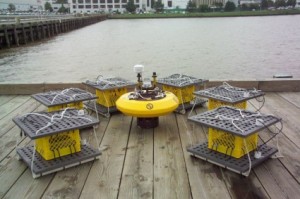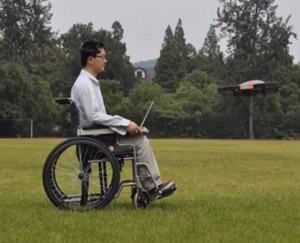The U.S. Navy’s recent testing of a Protector unmanned surface vessel (USV) with the Precision Engagement Module (PEM) weapons system warrants deeper analysis than provided by news reporting. The project is sponsored by the Chief of Naval Operation’s Expeditionary Warfare Division (N95) and the Naval Sea Systems Command’s Naval Special Warfare Program Office. To understand the ramifications of this testing, it’s worthwhile to elaborate a bit on the components that make up the PEW:
Toplite EOS – The Protector’s Electro-Optical Surveillance, Observation, and Targeting System consists of a four-axis gimbal stabilized turret housing a FLIR, low-light television camera, an eye-safe Laser Range Finder (LRF), and a Night Vision Imaging System (NVIS) compatible, laser target illuminator. The system interfaces to the USV’s radar, navigation systems (Inertial Navigation System and GPS), and the MK 49 weapons mount.
MK 49 Mod 0 – Based on the mini-Typhoon family of lightweight, stabilized, remote-controlled weapons mounts, the MK 49 is a joint venture between Rafael and General Dynamics. The Navy’s MK 49 features a .50 caliber machine gun in addition to the dual-missile pod. A larger version of the Typhoon forms the basis of the Navy’s Mk 38 Mod 2, 25 mm remotely operated chain guns currently installed on several classes of warships.
Spike LR – The 13 kg fire-and-forget weapon is derived from Rafael’s original Spike anti-armor weapon. The Spike missile uses electro-optic and infrared sensors to identify and lock onto the target. The missile can be guided en route to the target by a thin fiber optic tether that is spooled up and uncoils automatically during flight, providing the operator with a real-time first person view. The Spike’s 4 kilometer range and tandem warhead makes it effective against moving or stationary targets at sea or ashore, including boats and armored vehicles. Six Spikes were fired on October 24, all of them hitting their target.
How could such a platform be employed tactically? In a counter-swarm scenario, a GEN I Mothership would deploy with four to six Protectors in the well deck. Operating in conjunction with UAVs, helicopters, or maritime patrol aircraft, the Protectors would be cued towards a group of enemy fast attack craft (FAC) or fast inshore attack craft (FIAC). When the appropriate engagement criteria were met, the USV would launch its salvo of two SPIKE missiles into the enemy swarm, leaving “leakers” for armed UAS, helos, or a ship’s defensive weapons. Other perturbations of this scenario involve the use of USVs to draw a manned boat swarm away from high value units, or towards an airborne ambush. Similar to the way UAVs are operated, the USVs would patrol in 24 hour “orbits” each watching a sector oriented to a potential threat (such as a known FAC/FIAC operating base). The USVs would also screen high value units (carriers, lightly armed supply ships, etc.) during strait or chokepoint transits.
Another way this type of compact weapons system could be employed is to provide economical, rapidly deployable anti-surface firepower in an inland sea or riverine environment. As an example, the oil rich Caspian Sea is currently undergoing somewhat of a naval arms race, with Iran, Turkmenistan, and Kazakhstan all adding bases and warships there. The ability of the U.S. Navy to engage in that environment is limited, but flying in armed USVs to a near-by friendly base would provide at least a minimal anti-surface surveillance and engagement capability. The craft could even be modified for air-drop, like the similarly sized 11 meter RHIB Maritime Craft Aerial Deployment System (MCADS) in use with the Navy’s Special Boat Teams.
With additional autonomous features, a USV like the Protector could perform as a lethal autonomous robot (LAR). Jeffrey S. Thurnher argues that the pace of future warfare against threats such as Iranian boat swarms warrants the speed enabled by autonomous decision making in USVs. Although the Protector uses Rafael’s Lightlink jam-resistant communications system, in a future conflict, adversary jamming and cyber-attack capabilities will require drones to autonomously identify, track, and target enemy vessels without the interface of a manned operator.
The PEM testing follows the Navy’s recent trend of providing additional firepower to existing surface ships. In addition to the above-mentioned MK 38 chain gun serving across the fleet, the Navy’s Patrol Coastal class currently operating in the Persian Gulf will soon be fitted with the Griffin short-ranged missiles. These improvements indicate a degree of urgency in preparing for the counter-swarm mission. According to NAVSEA, the “USV PEM project was developed in response to recent world events involving swarms of small attack craft, as well as threat assessments outlined in recent studies conducted by the Naval Warfare Development Command.”






